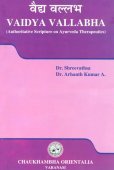Anushtup, Anuṣṭup: 6 definitions
Introduction:
Anushtup means something in Hinduism, Sanskrit, Marathi. If you want to know the exact meaning, history, etymology or English translation of this term then check out the descriptions on this page. Add your comment or reference to a book if you want to contribute to this summary article.
The Sanskrit term Anuṣṭup can be transliterated into English as Anustup or Anushtup, using the IAST transliteration scheme (?).
In Hinduism
Natyashastra (theatrics and dramaturgy)
Source: Wisdom Library: Nāṭya-śāstraAnuṣṭup (अनुष्टुप्) is a variant spelling for Anuṣṭubh, which refers to a class of rhythm-type (chandas) containing eight syllables in a pāda (‘foot’ or ‘quarter-verse’), according to the Nāṭyaśāstra chapter 15.

Natyashastra (नाट्यशास्त्र, nāṭyaśāstra) refers to both the ancient Indian tradition (shastra) of performing arts, (natya—theatrics, drama, dance, music), as well as the name of a Sanskrit work dealing with these subjects. It also teaches the rules for composing Dramatic plays (nataka), construction and performance of Theater, and Poetic works (kavya).
Purana and Itihasa (epic history)
Source: archive.org: Puranic EncyclopediaAnuṣṭup (अनुष्टुप्).—One of the seven horses of the Sun God, the other six being, Gāyatrī, Bṛhatī, Uṣṇik, Jagatī, Triṣṭup and Paṅkti. (Viṣṇu Purāṇa, Part II, Chapter 8).

The Purana (पुराण, purāṇas) refers to Sanskrit literature preserving ancient India’s vast cultural history, including historical legends, religious ceremonies, various arts and sciences. The eighteen mahapuranas total over 400,000 shlokas (metrical couplets) and date to at least several centuries BCE.
Kavyashastra (science of poetry)
Source: Shodhganga: Bhismacaritam a critical studyAnuṣṭup (अनुष्टुप्) is the name of a Sanskrit metre (chandas) employed in the Bhīṣmacarita (Bhishma Charitra) which is a mahākāvya (‘epic poem’) written by Hari Narayan Dikshit.—In poetry admitting science, very long metres are of no use; in a work on science admitting poetry, the length of the metres (varies) with the sentiment. One well-versed in poetry should use Anuṣṭup metre in all works which are of the type of the Purāṇas, or which are didactic in nature, and aim at clear exposition.—Following the same rule our poet has also appropriately used Anuṣṭup metre. The advice of inviting guests is given in verse III.37 of the Bhīṣmacarita.

Kavyashastra (काव्यशास्त्र, kāvyaśāstra) refers to the ancient Indian tradition of poetry (kavya). Canonical literature (shastra) of the includes encyclopedic manuals dealing with prosody, rhetoric and various other guidelines serving to teach the poet how to compose literature.
Languages of India and abroad
Marathi-English dictionary
Source: DDSA: The Molesworth Marathi and English Dictionaryanuṣṭup (अनुष्टुप्).—f (S) A measure of verse, the stanza consisting of 4 lines of 8 syllables each, or 3 lines of 8, 12, and 12. 2 A stanza of such measure. Ex. vidyayā vapuṣā vācā vastrēṇa vibhavēna vā || vakārai: pañcabhirhīnō narō nāprōti gauravaṃ || 3 n (Jocosely, from the above.) A little quantity; a mere drop;--used esp. of clarified butter.
Source: DDSA: The Aryabhusan school dictionary, Marathi-Englishanuṣṭup (अनुष्टुप्).—f A metre consisting of four Pâdas of 8 syllables each.
Marathi is an Indo-European language having over 70 million native speakers people in (predominantly) Maharashtra India. Marathi, like many other Indo-Aryan languages, evolved from early forms of Prakrit, which itself is a subset of Sanskrit, one of the most ancient languages of the world.
Sanskrit dictionary
Source: DDSA: Paia-sadda-mahannavo; a comprehensive Prakrit Hindi dictionary (S)Anuṣṭup (अनुष्टुप्) in the Sanskrit language is related to the Prakrit word: Aṇuṭṭhubha.
Sanskrit, also spelled संस्कृतम् (saṃskṛtam), is an ancient language of India commonly seen as the grandmother of the Indo-European language family (even English!). Closely allied with Prakrit and Pali, Sanskrit is more exhaustive in both grammar and terms and has the most extensive collection of literature in the world, greatly surpassing its sister-languages Greek and Latin.
See also (Relevant definitions)
Starts with: Anushtupchandas, Anushtupkarmina, Anushtuppu, Anushtupsampad, Anushtupshiras, Anushtupshirshan, Anushtupshloka, Anushtupu.
Full-text (+16): Anushtubh, Anushtupshirshan, Anushtuk, Anushtupchandas, Anushtupshiras, Karmina, Anutthubha, Anushtupkarmina, Anushthubha, Ushnik, Trishtup, Nashtarupa, Atri, Rishicchands, Vidyullekha, Shastra, Anushtupshloka, Cittavilasita, Bhaskaracarya, Vidyunmala.
Relevant text
Search found 35 books and stories containing Anushtup, Anuṣṭup, Anustup; (plurals include: Anushtups, Anuṣṭups, Anustups). You can also click to the full overview containing English textual excerpts. Below are direct links for the most relevant articles:
Garga Samhita (English) (by Danavir Goswami)
Verse 4.19.3a < [Chapter 19 - A Thousand Names of Srī Yamunā]
Verse 8.13.4 < [Chapter 13 - A Thousand Names of Lord Balarāma]
Women in the Atharva-veda Samhita (by Pranab Jyoti Kalita)
1. List of Hymns pertaining to Women < [Chapter 2 - The Strīkarmāṇi Hymns of the Atharvaveda]
The Chariots Of Navgrahas < [Astrology In Garuda Purana]
Mudrarakshasa (literary study) (by Antara Chakravarty)
2.2. Use of Anuṣṭup metre < [Chapter 4 - Employment of Chandas in Mudrārākṣasa]
Rig Veda (translation and commentary) (by H. H. Wilson)
The Garuda Purana (by Manmatha Nath Dutt)
Related products
